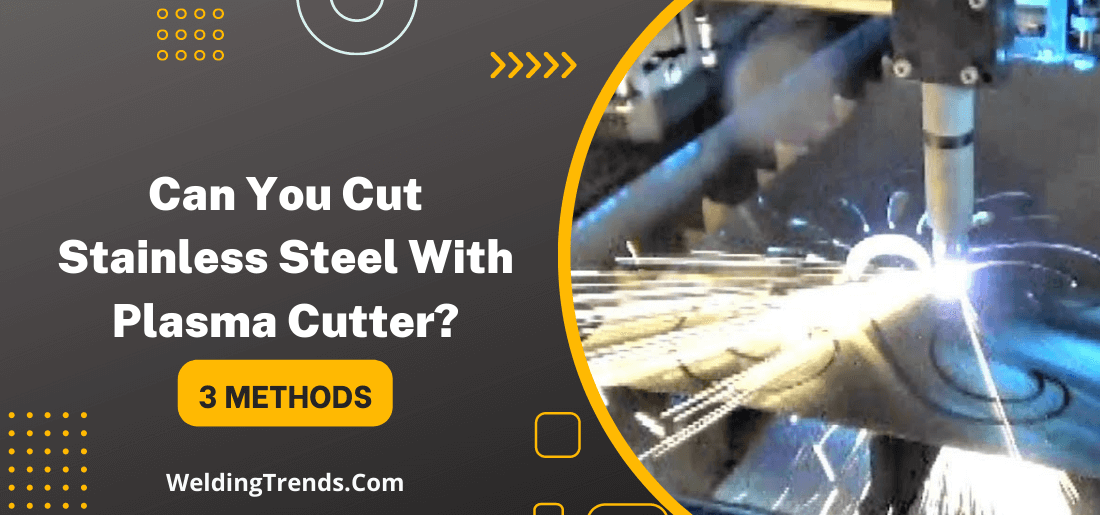Yes, you can cut stainless steel with a plasma cutter. Plasma cutting is a process that uses high-temperature plasma to cut through metal. Stainless steel is a particularly good material to cut with a plasma cutter because it is durable and doesn’t corrode easily.
In this blog post, we’ll take a closer look at how to cut stainless steel with a plasma cutter and provide some tips to make the process go as smoothly as possible. Let’s get started!
What is a plasma cutter and how does it work?
Plasma cutter is a powerful tool that uses high-temperature plasma to cut through metal. The plasma is created by superheating a gas, such as air, and then directing it through a narrow nozzle. This creates a high-speed stream of plasma that can cut through metal quickly and easily.
The cutting speed is the rate at which the plasma stream moves across the surface of the metal. The faster the cutting speed, the easier it will be to cut through the metal. However, if the cutting speed is too high, the quality of the cut will suffer.
The power setting controls the amount of energy that is directed into the plasma stream. The higher the power setting, the easier it will be to cut through the metal. However, if the power setting is too high, the quality of the cut will suffer.
How to cut stainless steel with a plasma cutter?
There are a few ways to cut stainless steel with a plasma cutter:
1) Using the drag tip
This is the most common way to cut stainless steel with a plasma cutter. To do this, you will need to use a slightly larger drag tip than you would use for cutting mild steel. This will help to prevent the stainless steel from sticking to the tip.
2) Starting the cut with a piercing tip
If you are having difficulty starting the cut with a drag tip, you can try using a piercing tip. This will help to get the cut started and then you can switch to a drag tip.
3) Cutting stainless steel sheets
When cutting stainless steel sheets, it is important to use a guide to help keep the cutter in a straight line. You can use a piece of an angle iron or a length of pipe. Place the guide on top of the stainless steel and start the cut. Once you have started the cut, move the guide along with the cutter.
With any of these methods, it is important to go slowly at first and increase the speed as you get more comfortable with the cutter. Stainless steel can be difficult to cut, so it is important to take your time and be patient.
Benefits of using a plasma cutter to cut stainless steel
Plasma cutters offer several advantages when cutting stainless steel. They are fast, efficient, and easy to use. Plasma cutters can also cut through thick pieces of stainless steel.
In addition, plasma cutters can be used to create intricate designs and patterns in stainless steel. This is because the plasma stream can be directed in any direction, making it easy to create complex shapes.
Plasma cutters produce a minimal amount of heat, which helps to prevent the warping and distortion of the metal.
Lastly, plasma cutters are less likely to cause sparks, which makes them a safer option than traditional methods, such as oxy-fuel cutting.
Things you should consider before using a plasma cutter to cut stainless steel
There are a few things you should consider before using a plasma cutter to cut stainless steel:
- The type of plasma cutter you use: When choosing a plasma cutter, make sure to choose one that is powerful enough to cut through stainless steel.
- The power setting: Start with a lower power setting and gradually increase it until you find the setting that works best for cutting through the stainless steel.
- The cutting speed: Go slowly at first and then increase the speed as you get more comfortable with the cutter.
- The type of tip you use: For cutting stainless steel, it is best to use a drag tip or a piercing tip.
- The thickness of the stainless steel: If you are cutting through a thick piece of stainless steel, it is best to use a guide to help keep the cutter in a straight line.
Following these tips will help you to cut through stainless steel quickly and easily.
Also Read: What Shade Lens Is Required For Plasma Cutting?
Tips for getting most out of your plasma cutter when cutting stainless steel
While plasma cutting is an incredibly versatile tool, there are a few things you should keep in mind when using it to cut stainless steel.
Here are some tips to help you get the most out of your cutter:
- Use a lower cutting speed: When cutting stainless steel, it’s important to use a lower cutting speed than you would with other materials. This will help to prevent the material from warping or becoming damaged.
- Use a higher amperage setting: Again, this will help to prevent damage to the stainless steel.
- Make sure your plasma cutter is properly grounded: Stainless steel is a conductive material, so it’s important to make sure your cutter is properly grounded. This will help to prevent any electrical accidents.
- Use a nozzle with a smaller orifice: This will help to concentrate the plasma jet and make for a cleaner, smoother cut.
- Use a dedicated stainless steel cutting tip: These tips are designed specifically for cutting stainless steel and will help to extend the life of your cutter.
By following these tips, you’ll be able to get the most out of your plasma cutter when cutting stainless steel.
FAQs – cut stainless steel with plasma cutter
What should you not cut with a plasma cutter?
There are a few materials that you should avoid cutting with a plasma cutter. These include:
- Aluminum: While aluminum is a conductive material, it tends to melt and distort when cut with a plasma cutter. This can damage your cutter and create a messy, unusable piece of aluminum.
- Cast iron: Cast iron is extremely hard and brittle, making it difficult to cut with a plasma cutter. In addition, the high heat generated by the cutter can cause the iron to shatter.
- Copper: Copper is another conductive material that can be damaged by the high heat of a plasma cutter. It’s also difficult to cut cleanly, so you’re likely to end up with a messy, unusable piece of copper.
So, there you have it – a few materials that you should avoid cutting with your plasma cutter. Stick to cutting stainless steel and other metals, and you’ll be sure to get the best results.
Which cutting process is best for stainless steel?
There are a few different processes that can be used to cut stainless steel. These include:
- Plasma cutting: This is a very versatile and effective way to cut stainless steel. It uses a high-powered plasma torch to cut through the metal.
- Oxy-acetylene cutting: This is another popular way to cut stainless steel. It uses a flame to heat the metal and then an oxygen torch to cut through it.
- Waterjet cutting: This is a newer, more precise way to cut stainless steel. It uses a high-powered stream of water to cut through the metal.
So, which process is best for cutting stainless steel? There’s no simple answer – it depends on the application. If you need to cut stainless steel quickly and efficiently, then plasma cutting is a good option. If you need to make a precise cut, then waterjet cutting may be the best choice.
Are plasma-cutting stainless steel hazards?
There are a few potential hazards associated with plasma-cutting stainless steel. These include:
- Fire
- Injury
- Electrical shock
By taking the proper precautions, you can avoid these hazards and safely use a plasma cutter to cut stainless steel.
Do you need a respirator for plasma cutting?
Yes, you should always wear a respirator when using a plasma cutter. The fumes generated by the cutter can be dangerous, so it’s important to protect yourself. A respirator will help to filter out harmful fumes and keep you safe.
Do you need dark glasses when using a plasma cutter?
Yes, you should always wear dark glasses when using a plasma cutter. The bright light generated by the cutter can be harmful to your eyes, so it’s important to protect them. Wearing dark glasses will help to reduce the risk of eye damage.
Conclusion
The short answer is yes, you can cut stainless steel with a plasma cutter. A plasma cutter can make quick work of cutting through stainless steel. Plus, there’s no need to worry about safety since plasma cutters are very safe to use.
However, the quality of the cut will not be as good as if you were to use an oxy-fuel torch. If you need to make a clean and precise cut on stainless steel, it is best to use an oxy-fuel torch.




